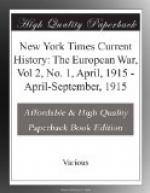It is to be hoped that a large portion of this commerce, which has been the artificial outgrowth of unusual conditions, will continue, even after the present world crisis shall happily have become a thing of the past. Surely, it would be to the mutual advantage of both countries to develop and strengthen their direct trade relations.
FROM ENGLAND
By MAURICE HEWLETT.
[From King Albert’s Book.]
O men of mickle heart and
little speech,
Slow, stubborn
countrymen of heath and plain,
Now have ye shown
these insolent again
That which to Caesar’s
legions ye could teach,
That slow-provok’d is
long-provok’d. May each
Crass Caesar learn
this of the Keltic grain,
Until at last
they reckon it in vain
To browbeat us who hold the
Western reach.
For even as you are, we are,
ill to rouse,
Rooted in Custom, Order, Church,
and King;
And as you fight for their
sake, so shall we,
Doggedly inch by inch, and
house by house;
Seeing for us, too, there’s
a dearer thing
Than land or blood—and
that thing Liberty.
War Correspondence
The Beloved Hindenburg
A Pen Portrait of the German Commander in Chief in the East
[By a Staff Correspondent of THE NEW YORK TIMES.]
GERMAN GREAT HEADQUARTERS, EAST, Feb. 10.—But for the “field gray” coat and the militant mustache, I should have taken him for a self-made American, a big business man or captain of industry, as he sat at his work desk, the telephone at his elbow, the electric push-buttons and reams of neat reports adding to the illusion. Quiet, unassuming, and democratic, he yet makes the same impression of virility and colossal energy that Colonel Roosevelt does, but with an iron restraint of discipline which the American never possessed, and an earnestness of face and eye that I had only seen matched in his Commander in Chief, the Kaiser. Here was a man whom the most neutral American could instantly admire and honor, regardless of the merits of the controversy. It was Hindenburg, the well beloved, the hope of Germany. He has already been “done” by journalists and Senator Beveridge, but 70,000,000 are pinning their faith to him, which makes him worth “doing” again—and again.
For a moment I nearly forgot that I was an American with “nerve,” bent on making him say something, preferably indiscreet; it seemed almost a shame to bother this man whose brain was big with the fate of empire. But, although I hadn’t been specially invited, but had just “dropped in” in informal American fashion, the Commander in Chief of all his Kaiser’s forces in the east stopped making history long enough to favor me with a short but thought-provoking interview.
As to his past performances, the Field Marshal genially referred to the detailed official summary; as to the future, he protested.




